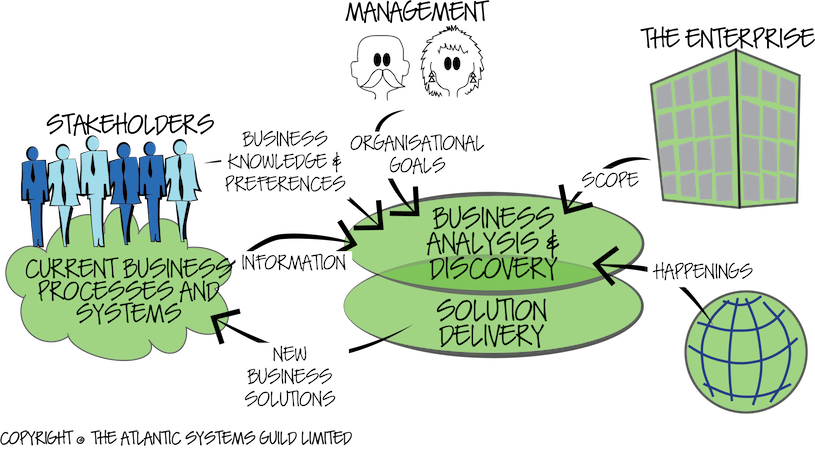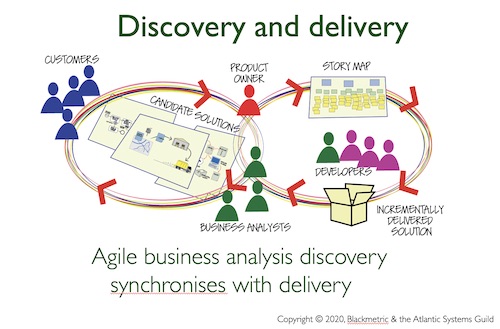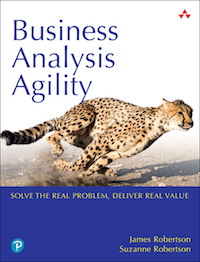
Business Analysis Agility
26-27 November 2020 (9-17h CET)
Location: Live Online Event (@YOUR DIGITAL WORKPLACE)
Presented in English by Adrian Reed and James Robertson
Price: 1250 EUR (excl. 21% VAT)

This event is history, please check out the NEXT SESSION
Check out these related open workshops:
- Generatieve Business Analyse (4de sessie) (May 28, 2024)
Check out our related in-house workshops:
- BPMN 2.0 Syntax and Positioning (In-Company) (INHOUSE WORKSHOP - On Request)
- BPMN 2.x in Practice (In-Company Workshop) (INHOUSE WORKSHOP - On Request)
- Case Modellering en CMMN in de Praktijk (INHOUSE WORKSHOP - On Request)
- Business Analyse Technieken (Workshop) (INHOUSE WORKSHOP - On Request)
- BPMN Jumpstart (In-Company) (INHOUSE WORKSHOP - On Request)
- Apache Spark Hands-On Training (In-Company) (INHOUSE WORKSHOP - On Request)
- Het Logisch Datawarehouse - Architectuur, Ontwerp en Technologie (INHOUSE WORKSHOP - On Request)
- Case Modelling and CMMN in Practice (INHOUSE WORKSHOP - On Request)
- Business Intelligence en Datawarehousing Fundamentals (INHOUSE WORKSHOP - On Request)
- Big Data Oplossingen voor BI (INHOUSE WORKSHOP - On Request)
- Lean Business Analyse (INHOUSE WORKSHOP - On Request)
- BizAgi Modeler in Theorie en Praktijk (INHOUSE WORKSHOP - On Request)
- Business Analyse Technieken (Tweedaagse Workshop) (INHOUSE WORKSHOP - On Request)
- Business Rule Modellering met DMN en BPMN (INHOUSE WORKSHOP - On Request)
- Business Analysis Agility (INHOUSE WORKSHOP - On Request)
- Minimum Viable Products (MVPs) Demystified (INHOUSE WORKSHOP - On Request)
- Aan de Slag met RPA, UiPath en Blue Prism (INHOUSE WORKSHOP - On Request)
Learning Objectives
Business Analysis Agility shows you how to: (also check out this 2-minute video)
- Understand and solve your customer’s real business problem
- Be more responsive to your customers and their real work
- Discover the capabilities of your customers and design better solutions for them
- Work in an agile and iterative manner with your customers
- Work in synchronisation with the agile development team
- Communicate more precisely with the developers by writing the right stories
The emphasis of this course is to show you how to work with your customers in a more agile way to ensure that you — and they — discover the right problem. In short, we show you how the business analyst is crucial to good agile development, and how you become a valued member of the agile team.
This interactive live online workshop is so much more than a webinar
- Teaching chapters are reinforced with hands-on workshops (via break-out rooms and collaborative whiteboards)
- The course is run interactively with lots of opportunity to discuss issues with the instructor, and with other participants
- You are shown how the course applies to your own work situation
- Your instructors have real world experience, and are willing to discuss how you can be most effective doing business analysis in your organisation
Why we organize this workshop: Increasing importance of business analysis and business analysts
The business analysts work closely with the customers to establish their work and its needs, and to ensure that the real business problem — it’s not always obvious, and not always what is said — is clearly understood by everybody.
To uncover the problem, the agile business analyst uses multiple candidate solutions to probe the customers, their objectives and their values. Candidate solutions are the preferred way of working as they have shown themselves to be extremely effective at prompting customers to reveal their real problems and underlying needs.
Business analysts use a story map to communicate the requirements for the solution to the developers. This means that the analysts and the developers work together iteratively and incrementally. The analysts are adding stories about the needs of the solution and the customers as the developers enhance and retrieve the stories in time for each development cycle. With co-ordination from the product owner, the analysts and the developers synchronise their efforts so business analysis results are delivered just in time for the next development cycle. The emphasis throughout is on close collaboration, and a relentless focus on solving the right problem.
This workshop is based on a brand new book with the same name. We will send this to you before the workshop, as well as the handouts.
This workshop is aimed at business analysts working with an agile team
| FREE BOOK for all participants: |
Business analysis is a skill that should be present in all development efforts, and in day-to-day organisational tasks. The skill is usually, but not necessarily, associated with job titles such as:
- Business Analyst
- Product Owner
- Agile Team Member
- Systems Analyst
- Project Leader
- Requirements Engineer
- Product or Program Manager
- or similar titles.
We also believe that Business Stakeholders, Users, Software Customers and Testers will benefit from learning advanced business analysis techniques, and how they can contribute to the organisation's wellbeing.
This workshop helps you understand the real problem, and find the best solution
This course gives you a different approach to business analysis. This one provides a business analysis framework that works regardless of whether you are part of an agile environment and need to provide stories for iterative development, or whether you are in a traditional environment and need to produce a requirements specification suitable for more formalised environments and outsourcing.
You learn how to:
- Find the customer (or user) segments, and determine which of them yields the best, and the earliest value
- Use safe-to-fail probes to ensure that a candidate solution solves the right problem and delivers the right value
- Deploy an iterative approach to discovering the real problem, and progressively feed the right stories to the delivery activity
- Understand that by discovering the right needs and solving the right problem, you deliver real value to your customer and your sponsor
- Do business analysis more quickly and effectively
What’s in it for You ?
This two-day course in business analysis gives you the skills and tools to discover your client's real business, and to determine and demonstrate the best ways of improving it.
It gives you a vision of the modern business analyst, one who understands the business analyst's role is much more than writing requirements. This course is a natural companion to Mastering the Requirements Process, where we teach the art of requirements writing. The models and understanding from Business Analysis Agility are the foundation for your requirements process.
Full Programme
| FREE BOOK for all participants: |
This programme is spread over 2 days, from 9h00 till 17h00. There is a morning coffee/tea break, a lunch break and an afternoon coffee/tea break. Our workshop leaders will answer your questions and talk about your specific business analysis, requirements and/or innovation problems that you have, after the workshop, from 17h00 till 17h30.
James Robertson is an experienced consultant, teacher, author and practitioner whose area of concern is the requirements for products, and the contribution that good requirements make to successful projects. His work in the area of business analysis and requirements gathering is valued by clients around the world.
Adrian Reed is a true advocate of the business analysis profession. In his day job, he acts as Principal Consultant and Director at Blackmetric Business Solutions where he provides Business Analysis consultancy and training solutions to a range of clients in varying industries.

We explore business analysis and show you how you can be more agile, more adaptable in your business analysis activities.
We take you through a framework for discovering the customers and their needs, for finding solutions and evaluating them, designing the business solution and getting it built. We look at how business analysis integrates with either agile or traditional development.
Identify and prioritise the customer segments. Customer, or user, segments are groups of people with the same characteristics and the same needs. For the highest priority segments, you produce value propositions that set down what you must deliver to satisfy the customers’ business needs. This value proposition is the foundation for what is to follow.
You ensure that it is worthwhile to provide value to a customer segment by looking at the value the segment brings to your organisation.
The business problem is, “How might you deliver the value proposition?” You and your team generate candidate solutions. Instead of stopping at one, you always find that subsequent candidates improve on the original.
To prove that a candidate is solving the right problem, each is the subject of a safe-to-fail probe. This is a quick, cheap experiment to determine the viability, the suitability and the outcome of a solution. You are also working with your customers to ensure that the candidate is solving the right problem and fulfilling the right need.

The solution space includes the people, software and devices used to fulfil the needs of the customer segments. When you are investigating this space, you are looking at the necessary business processes, and perhaps building process and data models of them to help with your understanding. You also scope the space so that the team can agree on the extent of the solution.
The solution involves, and is used by humans, so the investigation studies the culture and characteristics of the people involved in the solution. The investigation is quick, but thorough enough to prevent any nasty surprises for the development team.
Anything worthwhile is designed. Here you design the business solution to make it usable and convenient. The designing business analyst uses elements of the problem, the desired impact of the solution, the behaviour of the target customer segments, and the value proposition to craft the best possible solution.
Any valuable solution will be innovative. This section looks at some innovation techniques, especially in the areas of providing better information, and making the solution more convenient for its users.
Stories are fundamental to most agile development. However, if they are to be useful, the stories must be the right stories. This section gives you an approach to writing the right stories, ones that address the real customer problems.
We also show you how story maps give you a more descriptive and usable backlog. Story maps are the ideal repository for the information you are discovering, and the stories needed for the development cycles.
This section reviews the course and points out how by being agile, business analysis can be done quickly. We also look at other aspects of business analysis, how to break down silos, the minimal amount of effective documentation.
We demonstrate how business analysis can be integrated with, and improve Agile methods such as Scrum, Crystal, etc.
We take a look at lean thinking, and how the agile business analyst can avoid waste, unevenness and overburden.
While you can do your business analysis in an agile way, some organisations require a traditional requirements specification – so we show you how to build one from the results of your agile analysis.
Speakers

Adrian Reed is a true advocate of the analysis profession. In his day job, he acts as Principal Consultant and Director at Blackmetric Business Solutions where he provides business analysis consultancy and training solutions to a range of clients in varying industries. He is a Past President of the UK chapter of the IIBA® and he speaks internationally on topics relating to business analysis and business change. Adrian wrote the 2016 book 'Be a Great Problem Solver... Now' and the 2018 book 'Business Analyst'
You can read Adrian's blog at https://www.adrianreed.co.uk. Follow Adrian on Twitter @UKAdrianReed and LinkedIn.

James Robertson is a consultant, teacher, author, project leader whose area of concern is the requirements for products, and the contribution that good requirements make to successful projects. His work in the area of business analysis and requirements gathering is valued by clients around the world.
He is the co-author of the best-selling book "Mastering the Requirements Process, Third Edition" (Pearson, 2012, ISBN: 9780321815743). This book provides guidance on finding requirements and writing them so that all the stakeholders can understand them. He also co-founded the Volere approach to requirements engineering. His most recent book is "Adrenaline Junkies and Template Zombies: Understanding Patterns of Project Behavior", written with fellow principals of The Atlantic Systems Guild, a London and New York-based think tank known for its research into new systems engineering techniques.
James Robertson has worked on almost every type of information system. His experience has led him to write numerous seminars and papers that are well respected as sources of new software development ideas.
As well as teaching his seminars and workshops, he now advises companies on how to adapt modern software development techniques to fit specific projects, and how to effectively transfer the new technologies to the software developers within the organisation. He has formed a solid partnership with his wife Suzanne to consult on numerous large-scale projects in Europe and the United States.
James and Suzanne Robertson are principals and co-founders of The Atlantic Systems Guild.
The Atlantic Systems Guild Limited is endorsed as an education provider by the International Institute of Business Analysis (IIBA).
Questions about this ? Interested but you can't attend ? Send us an email !
